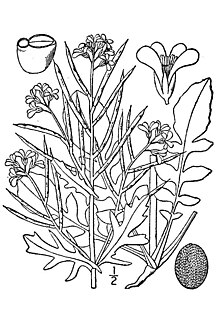Barbarea verna
| Land cress | |
|---|---|

| |
| Scientific classification | |
| Kingdom: | Plantae |
| Clade: | Tracheophytes |
| Clade: | Angiosperms |
| Clade: | Eudicots |
| Clade: | Rosids |
| Order: | Brassicales |
| Family: | Brassicaceae |
| Genus: | Barbarea |
| Species: | B. verna
|
| Binomial name | |
| Barbarea verna | |
| Synonyms[1] | |
| |
Barbarea verna is a biennial herb in the family Brassicaceae.[2] Common names include land cress, American cress, bank cress, black wood cress, Belle Isle cress, Bermuda cress, early yellowrocket,[3] early wintercress, scurvy cress, creasy greens, and upland cress.[4] It is native to southern Europe and western Asia, and naturalized elsewhere[5] It has been cultivated as a leaf vegetable in England since the 17th century. As it requires less water than watercress, it is easier to cultivate.
Uses
Land cress is considered a satisfactory substitute for watercress. It can be used in sandwiches, or salads, or cooked like spinach, or used in soup.[6]
Land cress can be grown easily in any garden. Like watercress, it loves water, but does not do well when partially submerged for long periods of time. This perennial needs full sun and frequent watering in any garden, unless near a direct source of water. It is a common green in Appalachian Cuisine as one of few plants that can overwinter in the mountains.[4]
Other common names include dryland cress, cassabully, and American watercress. When cooked similarly to Southern collard greens the leaves may be called creasy greens. A variegated form is available.
See also
References
- ^ The Plant List: A Working List of All Plant Species, retrieved 8 May 2016
- ^ "Barbarea verna (Mill.) Asch". Plants of the World Online. The Trustees of the Royal Botanic Gardens, Kew. n.d. Retrieved September 27, 2020.
- ^ English Names for Korean Native Plants (PDF). Pocheon: Korea National Arboretum. 2015. p. 371. ISBN 978-89-97450-98-5. Archived from the original (PDF) on 25 May 2017. Retrieved 26 January 2017 – via Korea Forest Service.
- ^ a b "What's in Season: Creasy Greens". Garden & Gun. 2017-11-30. Retrieved 2020-08-22.
- ^ USDA GRIN Taxonomy, retrieved 8 May 2016
- ^ Nyerges, Christopher (2017). Foraging Washington: Finding, Identifying, and Preparing Edible Wild Foods. Guilford, CT: Falcon Guides. ISBN 978-1-4930-2534-3. OCLC 965922681.
External links
 Media related to Barbarea verna at Wikimedia Commons
Media related to Barbarea verna at Wikimedia Commons- "Barbarea verna". Plants for a Future.
- Barbarea verna in the CalPhotos photo database, University of California, Berkeley


